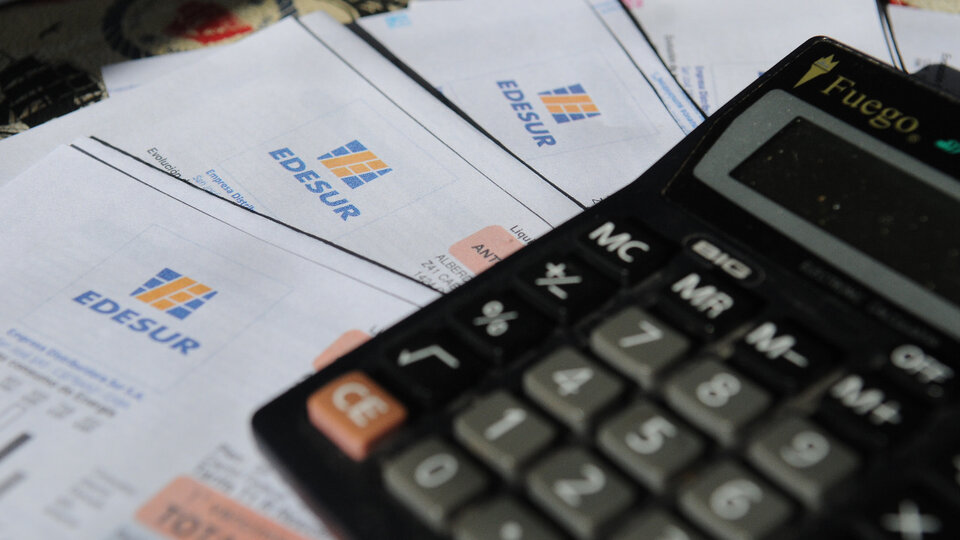gracielle
Registered
- Joined
- Jun 6, 2005
- Messages
- 3,631
- Likes
- 2,988
4 February 2022 by Sofia Diamante

 www.lanacion.com.ar
Tariff segmentation: who would be left without subsidies according to the project presented to Guzmán by the pro-Cristina wing of the Gov't. A report submitted by the ENRE identified around 487,000 residential users of the BA Metro Area (AMBA) that would no longer receive State contributions in their electricity bills.
www.lanacion.com.ar
Tariff segmentation: who would be left without subsidies according to the project presented to Guzmán by the pro-Cristina wing of the Gov't. A report submitted by the ENRE identified around 487,000 residential users of the BA Metro Area (AMBA) that would no longer receive State contributions in their electricity bills.
The first to present its segmentation project was the ENRE, which is under intervention by Soledad Manín, who answers to Federico Basualdo, Undersecretary of Electric Energy, an official very close to the former President. The design of the plan, based on the real estate value of users, was carried out by the Latin American Faculty of Social Sciences (Flacso) through the Conicet, and is focused on the AMBA region, where 40% of residential users are concentrated. The segmentation proposed by ENRE uses the National Tax and Social Identification System (Sintys), the National Social Security Administration (ANSES) and the Collection Agency of the Prov of BA (ARBA) as its database. "Exchanges of information have also been developed with various public agencies", stated the ENRE.
The first impression of the energy analysts about this project is that it would violate the cross-subsidies law and that, therefore, it could create a "shower of appeals", as an economist said in off. According to LA NACION, Guzmán's portfolio rejected this proposal and the economic team is working on another segmentation design in parallel. The designers of the ENRE's project, on the other hand, say that there are no cross-subsidies in the proposal. "That would happen if you charge one user more than what the service costs in order to subsidize another; that would not be happening," they clarified. Mauricio Roitman, former president of Enargas during the administration of Mauricio Macri, agreed with this explanation: "If only subsidies are removed, there is no problem of cross-subsidies (prohibited in the regulatory frameworks). The main drawback would be that the criterion of "gradualness" of the Cepis ruling (Centro de Estudios para la Promoción de la Igualdad y la Solidaridad), much celebrated by those who designed the current segmentation, would not be respected".
The agency had indicated that the subsidy would be removed from those residents of the City of BA who live in a property whose square meter has a value equal to or greater than US$ 3,700. In the GBA, the idea is to apply a compound formula based on the value of the land. According to the criteria chosen, the full rate will be paid by those plots of land whose value is four times the average for the area. Currently, residential users pay only 35% of the cost of electricity generation. The rest is covered by the Treasury. With the data obtained from the implementation of the geographic location methodology, around 487,000 residential users of the AMBA were identified as no longer having subsidies, according to the ENRE document. This represents 10% of the total number of residential users in this jurisdiction. "More than three quarters of these users are located in CABA, more precisely in Puerto Madero and in a large part of the neighborhoods of Recoleta, Palermo, Belgrano and Núñez, a part of Colegiales, some blocks of Villa Urquiza, Retiro, Saavedra and Villa Devoto and a high value area in Caballito", says the report. "In the GBA, 67,800 users were identified, who live in a specific area called 'el bajo' (the lowlands), comprising the districts of Vicente López and San Isidro. There are also 48,000 users in the 466 countries and other gated communities registered in the GBA, since they have a set of characteristics that make them accessible only to high-income sectors".
Users belonging to the national, provincial and municipal public sector, and businesses and industries that consume less than 300 Kw and that develop activities characterized by "having dollarized prices or external financing, that have high profitability and/or belong to non-tradable markets (so they do not compete with foreign markets)" will not receive subsidies either. These activities include the financial sector; highway concessionaires; urban and suburban passenger railroad transportation; generation, transportation and distribution of electricity and transportation and distribution of gaseous fuels; services of extraterritorial organizations and bodies (embassies); and gambling and betting entities. Other sectors that were excluded from the subsidy are "residential users in gated communities or not, who contract more power in their homes due to the equipment and infrastructure they have, which is an indication of their high purchasing power; and common spaces in gated communities and countries".
The report clarifies that users who are beneficiaries of the social tariff "will continue under this regime and in no case will be included in the removal of subsidies". On the other hand, users residing in the selected geographic areas may request the continuity of the subsidy, but to do so they must complete a form with data showing that they do not have the economic capacity to pay the full cost of the electricity tariff, explained the ENRE. The Secretary of Energy, Darío Martínez, said today on Twitter that the "ENRE, Conicet and Enargas submitted proposals that are being worked on by the Undersecretary of Planning which, together with the team of the Ministry of Economy, is in charge of the design of the tool, which will be applied when the Gov't makes the decision".

Segmentación de tarifas: quiénes se quedarían sin subsidios según el proyecto que el ala cristinista le presentó a Guzmán
Un informe presentado por el ENRE identificó alrededor de 487.000 usuarios residenciales del área metropolitana de Buenos Aires (AMBA) que dejarían de recibir aportes del Estado en sus facturas de luz
The first to present its segmentation project was the ENRE, which is under intervention by Soledad Manín, who answers to Federico Basualdo, Undersecretary of Electric Energy, an official very close to the former President. The design of the plan, based on the real estate value of users, was carried out by the Latin American Faculty of Social Sciences (Flacso) through the Conicet, and is focused on the AMBA region, where 40% of residential users are concentrated. The segmentation proposed by ENRE uses the National Tax and Social Identification System (Sintys), the National Social Security Administration (ANSES) and the Collection Agency of the Prov of BA (ARBA) as its database. "Exchanges of information have also been developed with various public agencies", stated the ENRE.
The first impression of the energy analysts about this project is that it would violate the cross-subsidies law and that, therefore, it could create a "shower of appeals", as an economist said in off. According to LA NACION, Guzmán's portfolio rejected this proposal and the economic team is working on another segmentation design in parallel. The designers of the ENRE's project, on the other hand, say that there are no cross-subsidies in the proposal. "That would happen if you charge one user more than what the service costs in order to subsidize another; that would not be happening," they clarified. Mauricio Roitman, former president of Enargas during the administration of Mauricio Macri, agreed with this explanation: "If only subsidies are removed, there is no problem of cross-subsidies (prohibited in the regulatory frameworks). The main drawback would be that the criterion of "gradualness" of the Cepis ruling (Centro de Estudios para la Promoción de la Igualdad y la Solidaridad), much celebrated by those who designed the current segmentation, would not be respected".
The agency had indicated that the subsidy would be removed from those residents of the City of BA who live in a property whose square meter has a value equal to or greater than US$ 3,700. In the GBA, the idea is to apply a compound formula based on the value of the land. According to the criteria chosen, the full rate will be paid by those plots of land whose value is four times the average for the area. Currently, residential users pay only 35% of the cost of electricity generation. The rest is covered by the Treasury. With the data obtained from the implementation of the geographic location methodology, around 487,000 residential users of the AMBA were identified as no longer having subsidies, according to the ENRE document. This represents 10% of the total number of residential users in this jurisdiction. "More than three quarters of these users are located in CABA, more precisely in Puerto Madero and in a large part of the neighborhoods of Recoleta, Palermo, Belgrano and Núñez, a part of Colegiales, some blocks of Villa Urquiza, Retiro, Saavedra and Villa Devoto and a high value area in Caballito", says the report. "In the GBA, 67,800 users were identified, who live in a specific area called 'el bajo' (the lowlands), comprising the districts of Vicente López and San Isidro. There are also 48,000 users in the 466 countries and other gated communities registered in the GBA, since they have a set of characteristics that make them accessible only to high-income sectors".
Users belonging to the national, provincial and municipal public sector, and businesses and industries that consume less than 300 Kw and that develop activities characterized by "having dollarized prices or external financing, that have high profitability and/or belong to non-tradable markets (so they do not compete with foreign markets)" will not receive subsidies either. These activities include the financial sector; highway concessionaires; urban and suburban passenger railroad transportation; generation, transportation and distribution of electricity and transportation and distribution of gaseous fuels; services of extraterritorial organizations and bodies (embassies); and gambling and betting entities. Other sectors that were excluded from the subsidy are "residential users in gated communities or not, who contract more power in their homes due to the equipment and infrastructure they have, which is an indication of their high purchasing power; and common spaces in gated communities and countries".
The report clarifies that users who are beneficiaries of the social tariff "will continue under this regime and in no case will be included in the removal of subsidies". On the other hand, users residing in the selected geographic areas may request the continuity of the subsidy, but to do so they must complete a form with data showing that they do not have the economic capacity to pay the full cost of the electricity tariff, explained the ENRE. The Secretary of Energy, Darío Martínez, said today on Twitter that the "ENRE, Conicet and Enargas submitted proposals that are being worked on by the Undersecretary of Planning which, together with the team of the Ministry of Economy, is in charge of the design of the tool, which will be applied when the Gov't makes the decision".

